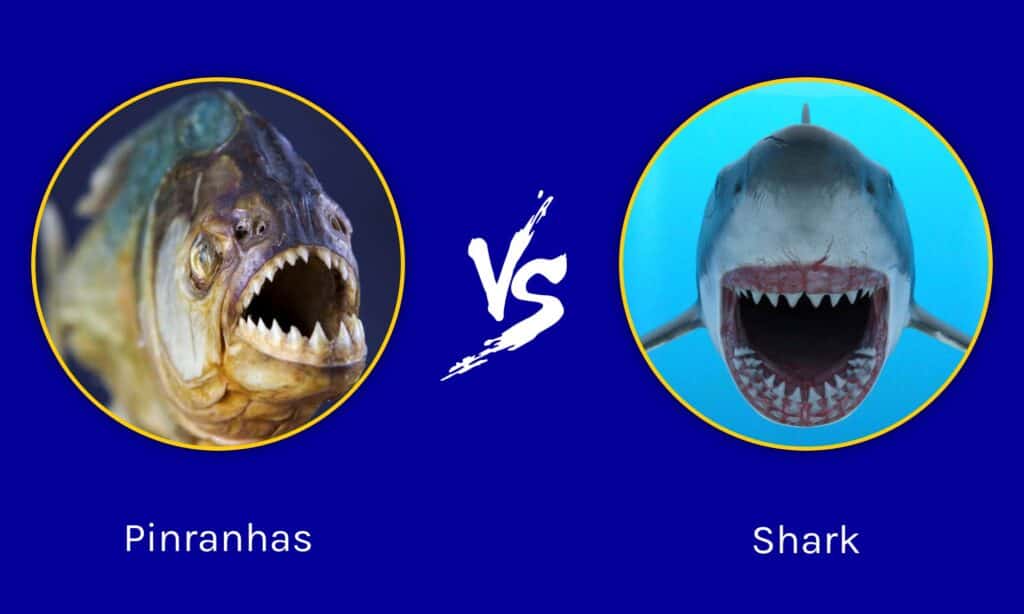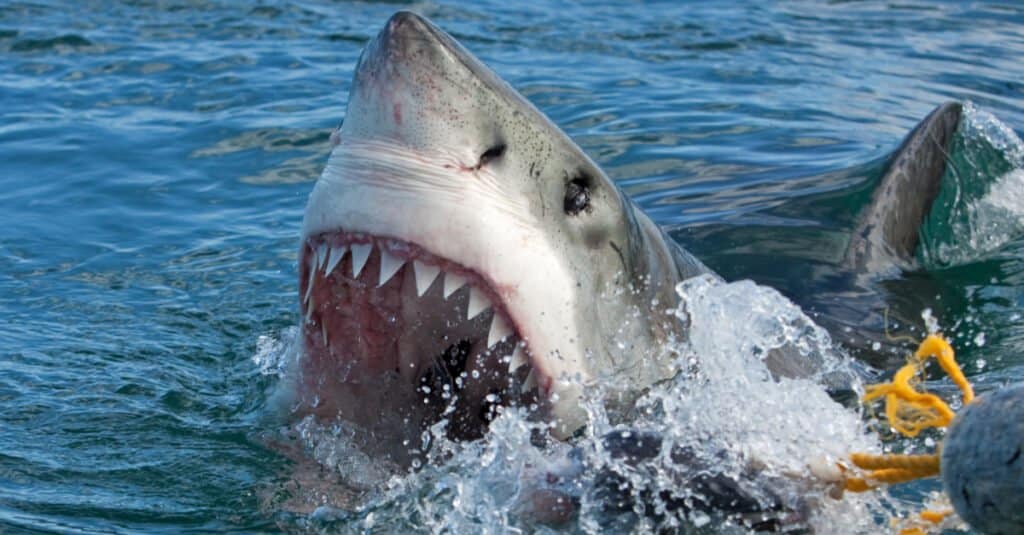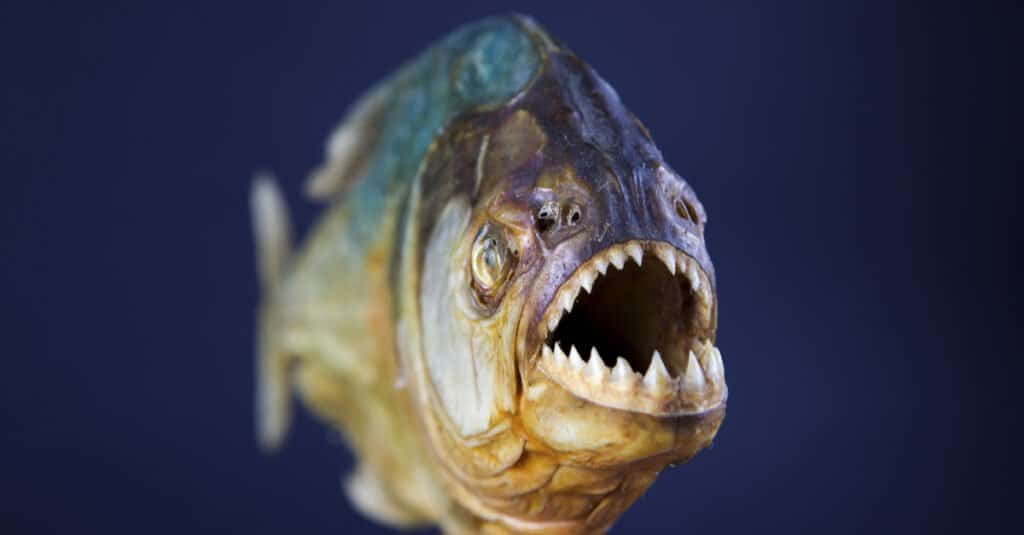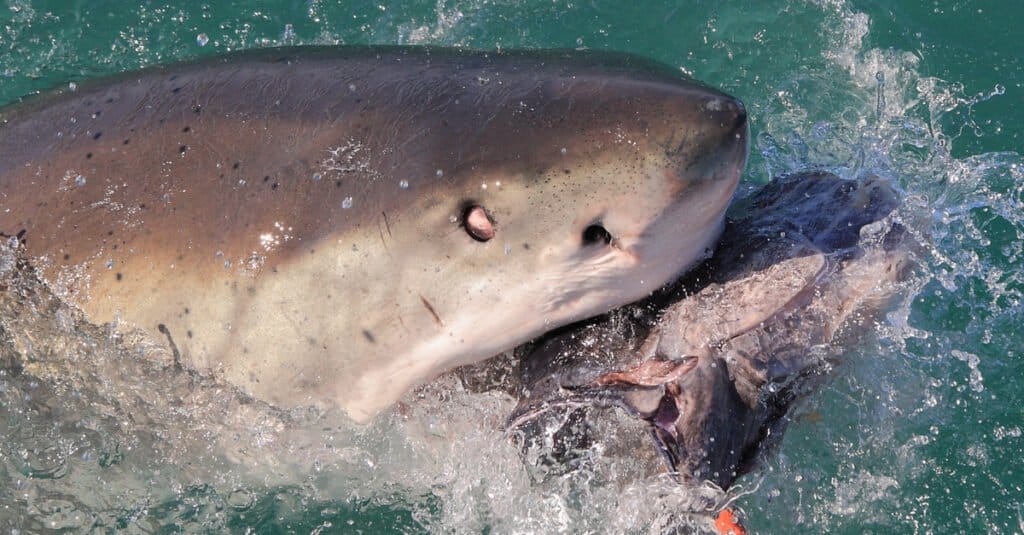Piranhas and sharks are two of the most feared fish in the world. Sharks have killed stranded sailors by the score in real life and haunted the collective cultural mindset of people since the release of Jaws. Schools of piranhas are rumored to have the ability to strip an entire cow of its flesh in just a few minutes. Which of these fish is the real deal? What would happen in the piranhas vs. shark match?
We’re going to break down this battle and show you which of these animals is most likely to win a fight. To make it a fair fight, we’re going to use data from the great white shark to face off against a school of piranhas. Also, we’ll imagine that both fish end up in a water solution that is comfortable for them since sharks are marine animals and piranhas are freshwater animals.
Comparing a Piranha and a Shark

| Piranhas | Shark | |
|---|---|---|
| Size | Weight: 3lbs-7lbs Length: 0.5ft-1.2ft | Weight: 2,000lbs-5,000lbs Length: 18ft – 26ft |
| Speed and Movement Type | – 15-25 mph as its short-range speed – 3 mph when swimming normally | – 20 mph-35 mph – Undulating, side-to-side motion for the tail and body. |
| Defenses | – Benefits from living in a school of fish – Average school size is between 20 and 30 fish – Speed to escape enemies | – Large size – Bursts of swim speed – Great senses that help it find or avoid other animals |
| Offensive Capabilities | – Incredibly sharp teeth and a powerful bite – 70 PSI bite – Bites and tears flesh with ease – Amazing sense of smell helps them locate prey | – 4000 PSI Bite Power – About 50 serrated teeth are available to bite in the first row, but 300 teeth overall – 2-4-inch-long teeth – Uses speed, size, and raw power to inflict devastating wounds on prey |
| Predatory Behavior | – Often scavenges rather than hunters – Opportunistic predators that find prey food and eat it – Omnivorous fish | – Both an opportunistic and ambush predator that often strikes from below an enemy |
What Are Key Differences Between a Piranhas and a Shark?

Sharks are powerful, stealthy, and massive.
©Martin Prochazkacz/Shutterstock.com
The greatest differences between piranhas and sharks are size, cooperation, and body shape. Sharks are solitary, torpedo-shaped cartilaginous fish that weigh between 2,000 and 5,000 lbs and grow up to 26ft in length. Piranhas are triangle-shaped school fish that weigh between 3lbs and 7lbs and grow up to 1.2ft long.
These differences represent a helpful starting point for figuring out which of these animals is more powerful. Yet, we need to perform a deep dive and examine other key factors to determine the winner of this fight with any certainty.
What Are the Key Factors in a Fight Between a Piranhas and a Shark?

Piranhas have serious biting power, and groups of them can prove fatal.
©simongee/Shutterstock.com
The most important factors in a fight between a shark and a piranha include size, grouping, offensive powers, and more. We’re going to look at five points of comparison for these animals, find out which one has the advantage, and then determine which one is superior. We’ll show you which of these aquatic animals is going to win and why!
Piranhas vs. Shark: Size
Sharks are much larger than piranhas. They can weigh between 2,000 and 5,000 lbs and measure up to 26ft long. Some of the larger piranhas might reach a weight of 7 lbs and measure a little over 1ft. The size disparity, in this case, is huge.
Sharks have the size advantage in this case.
Piranhas vs. Shark: Speed and Movement
Sharks are faster than piranhas. The great white shark can reach speeds of 35 mph by using its powerful tail and body to push it forward. However, piranhas only travel at about three mph, with a closing speed that may reach between 15 and 25 mph over very short distances.
Sharks have the speed advantage in this case.
Piranhas vs. Shark: Defenses
Sharks have superior defenses compared to piranhas. They are very large, have tough scales protecting their bodies, can swim at a rapid pace, and have a host of great senses that help them identify other creatures.
Piranhas live in a school that can reach sizes of 20-30 fish. That can provide some protection against predators, and they also have a good short-term speed burst to escape foes.
Sharks have the advantage in defenses.
Piranhas vs. Shark: Offensive Capabilities
The offensive powers of a shark cannot be understated. These animals can bite with a force of 4,000PSI, drive 50 razor-sharp teeth into their prey with every bite, and each tooth can be between 2 and 4 inches long, a significant portion of a piranha’s size. Sharks are powerful, undeniable hunters that have a host of senses tuned to help them capture and kill prey.
Piranhas are no pushovers. They have a 70PSI bite, very sharp teeth, and use a swift biting and tearing technique to strip flesh away from foes. Also, piranhas use their great sense of smell to help them locate and attack their prey.
Sharks have the advantage in offensive powers.
Piranhas vs. Shark: Predatory Behavior
Sharks are opportunistic and ambush predators that can swiftly attack prey, killing them in one shot or severely disabling them. They attack from below and behind their prey, ripping massive amounts of flesh away in a single bite.
Piranhas are scavengers and opportunistic predators. They are also omnivores. They don’t stalk and ambush their prey. Instead, they find it while swimming and then attack it.
Sharks have the advantage in terms of predatory behaviors.
Who Would Win in a Fight Between a Piranhas and a Shark?

A shark is too much for a school of piranhas to handle.
©Alessandro De Maddalena/Shutterstock.com
A shark would beat piranhas in a fight. To be clear, there is a limit to the number of piranhas that a shark could defeat in a battle. Piranhas tend to school in groups of 20 to 30 members, so those are the numbers that we’re going to use.
A shark could be able to attack and overwhelm the school, taking out several members before they know what’s going on. After that, the shark loses the advantage and has to snap at individuals. Let’s say the first attack takes out five piranhas.
Between 15 and 25 piranhas are left. Piranhas can only eat a few grams of food per day, so unless they suddenly start to ignore their instincts and keep attacking the shark without eating, they’re not going to win this battle.
Sharks can eat up to 2% of their body weight in each attack. That could be upwards of 100 lbs. With 25 piranhas weighing about 5 lbs on average, the shark could eat just about all the remaining piranhas.
That aside, sharks are apex predators, and piranhas are not. The sight of the massive fish tearing through its ranks is not going to make the piranhas more willing to attack the shark. They would probably flee.
We can break this fight down any number of ways, but the piranhas would need to act abnormally to even stand a chance of killing a shark. A shark merely has to use its power and speed to tear them apart, even if it takes a little while.
No matter how we slice it, though, sharks are going to come out on top unless a super school of 50-100 piranhas decides to chomp down on the shark.
Can Any Animal Win Against a Shark?
The thought of a battle between a shark and another aquatic creature is certainly fascinating. It’s difficult to determine which animal would win the fight, as each species has its own strengths and weaknesses in comparison to the other.
A possible contender for taking on sharks could be large fish such as tuna or swordfish. These creatures have long, sharp bills that they use to defend themselves against predators like sharks by stabbing them with their bills. They also swim at very high speeds, allowing them to outmaneuver the slower swimming shark and evade its attacks. If a battle were to take place between these species, it would likely involve some intense chasing and maneuvering until one of them was able to gain an advantage over the other.
Large cetaceans such as whales are another potential match for sharks in a fight due to their immense size and strength compared with that of a shark’s slender frame. Whales can also communicate using sonar signals, which may give them an edge in terms of locating prey or avoiding predators such as sharks before they get too close for comfort! In addition, if needed, whales can use their tails or fins as weapons by swinging them around at high speed in order to subdue attackers like smaller sharks or even groups of larger ones, should it come down to that!
The photo featured at the top of this post is © guentermanaus/Shutterstock.com
Thank you for reading! Have some feedback for us? Contact the AZ Animals editorial team.







